Jakob Porges/Purias/Bories (Porges) (1701<b.?<1861) married Rachel (?)

 N. Salomon Porges (b. ca 1766, d. Nyrsko 07/07/1812) married Abigail Berger (b. ca 1768, d. Neuern/Nyrsko 17/05/1840) N. Salomon Porges (b. ca 1766, d. Nyrsko 07/07/1812) married Abigail Berger (b. ca 1768, d. Neuern/Nyrsko 17/05/1840)
 Zezilie/Susana Fleisch (b. Vienna 1802, d. Budapest 11/04/1871) Zezilie/Susana Fleisch (b. Vienna 1802, d. Budapest 11/04/1871)
 Moyses Porges (b. Neuern/Nyrsko 15/06/1807, d.27/12/1809 (2y. old)) Moyses Porges (b. Neuern/Nyrsko 15/06/1807, d.27/12/1809 (2y. old))
 Theresie/Rosalia Bloch (b. Neuern/Nyrsko 05/05/1810, d. ?) married Loebl Bloch Theresie/Rosalia Bloch (b. Neuern/Nyrsko 05/05/1810, d. ?) married Loebl Bloch
 David Porges (b. ca 1766, d. Neuern/Nyrsko 19/07/1857)
David Porges (b. ca 1766, d. Neuern/Nyrsko 19/07/1857)
married 31/08/1809 Barbara Breindl Janowitzer (b. 1791, d. Neuern/Nyrsko 13/10/1863)
(daughter
of Seev Wolf Samuel Janowitzer and Emaile Hermann-Naftal)
Janowitzer
family tree
 Anna Tachau Porges (b. Neuern/Nyrsko Bohemia 12/09/1808)
Anna Tachau Porges (b. Neuern/Nyrsko Bohemia 12/09/1808)
[Anna was daughter of Barbara Janowitzer and is recorded as born out of wedlock.
In her marriages record she is recorded as Anna Janowitzer daughter of Barbara Janowitzer
daughter of Wolf Janowitzer and wife of David Porges.
Barbara Janowitzer married David Porges 31 Aug 1809 ie a year after Anna was born
so David might have been her father, but we do not know for sure.
Nyrsko HBMa 1435 N births 1807-1830 (divky/girls) image 5
and Nyrsko HBMa 1441 O marriages 1808 - 1830, image 5
both at www.badatelna.eu. Source : Geni.com]
 Rebeka Klauber Porges (b. Neuern/Nyrsko Bohemia 23/04/1813) Rebeka Klauber Porges (b. Neuern/Nyrsko Bohemia 23/04/1813)
 Judit Porges (b. Neuern/Nyrsko Bohemia15/07/1815, d. Nyrsko 16/08/1821 (6 y. old)) Judit Porges (b. Neuern/Nyrsko Bohemia15/07/1815, d. Nyrsko 16/08/1821 (6 y. old))
 Rosalia/Theresia Kohner Porges Rosalia/Theresia Kohner Porges
(b. Neuern/Nyrsko Bohemia 28/06/1816, d. Vseruby Plzen 16/09/1848)
 Sallomon Porges (b. Neuern/Nyrsko Bohemia 06/08/1819) Sallomon Porges (b. Neuern/Nyrsko Bohemia 06/08/1819)
 Anna (Hindl) Kohner Porges (b. Neuern/Nyrsko Bohemia 27/06/1826, d. Budapest 11/09/1883) Anna (Hindl) Kohner Porges (b. Neuern/Nyrsko Bohemia 27/06/1826, d. Budapest 11/09/1883)
 Wolf Porges (b. Neuern/Nyrsko Bohemia 06/11/1829, d. 25/03/1830 (4 months))
Wolf Porges (b. Neuern/Nyrsko Bohemia 06/11/1829, d. 25/03/1830 (4 months))
 Karolina Porges (b. Neuern/Nyrsko Bohemia 30/06/1835, d. 12/12/1835 (5 months)) Karolina Porges (b. Neuern/Nyrsko Bohemia 30/06/1835, d. 12/12/1835 (5 months))
 Sigmond Porges / Porias / Bories (b. Neuern/Nyrsko Bohemia 1822) Sigmond Porges / Porias / Bories (b. Neuern/Nyrsko Bohemia 1822)
married Therese Fleischel (b. 1826)
 |
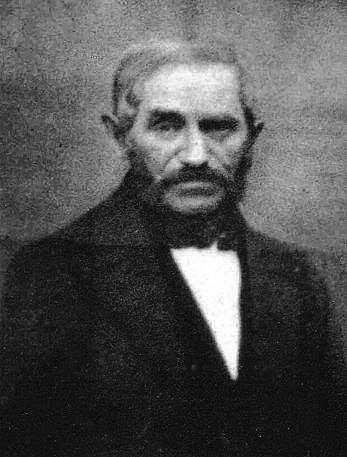
Samuel Porges
Courtesy of Hanni Marcus (USA)
and Gisela Porges (Vienna) |
Samuel Porges (b. Neuern/Nyrsko 17/12/1810, d. vNyrsko 17/12/1864)
married
Franziska Reichenbaum
(daughter of Aaron Reichenbaum and Theresia Epstein) |
 Theresia Porges (b. Neuern/Nyrsko Bohemia
23/01/1840) Theresia Porges (b. Neuern/Nyrsko Bohemia
23/01/1840)
 Lippmann Porges (b. Neuern/Nyrsko Bohemia 30/06/1843)
Lippmann Porges (b. Neuern/Nyrsko Bohemia 30/06/1843)
 |
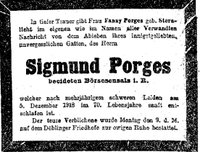 |
Sigmund Porges
(b. Neuern/Nyrsko 12/07/1849, d. Vienna 03/12/1918)
married
Fanni Sternlicht
(b. Brno 19/11/1856, d. KZ Treblinka > 29/09//1942) |
 Wilhelm Porges (b. Neuern/Nyrsko Bohemia12/07/1849, d. 17/01/1845 (5 weeks)) Wilhelm Porges (b. Neuern/Nyrsko Bohemia12/07/1849, d. 17/01/1845 (5 weeks))
 Jacob Porges (b. 20/06/1841, d. 01/04/1842 (9 months) twin with
Jacob Porges (b. 20/06/1841, d. 01/04/1842 (9 months) twin with
 Salomon Porges
Salomon Porges
(b. Neuern/Nyrsko Bohemia
20/06/1841, d. Spittal and der Drau Austria 1918)
: see below
 Salomon
Porges Salomon
Porges
(b. Neuern/Nyrsko near Klattau/Klatovy & Pilsen,
Bohemia 20/06/1841, d. Spittal an der Drau, Carinthia 1918)
Physician (M.D.) Salomon studied in Prague.
Married to Johanna Sattler (b. Cekanice near Blatna, Bohemia 1853,
d. Kalmar, Sweden 1956
at the age of 103).
They settled in Gmünd and then in Spittal.
Johanna escaped Nazis to Sweden in 1941.
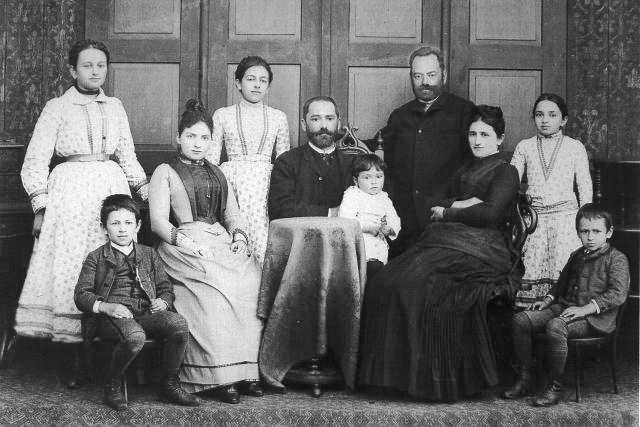
Salomon Porges, born 1841 in Neuern, with his family:
6 children, his wife Johanna (black), his brother Sigmund (centre
of the picture) and his wife (white).
Courtesy of Hanni Marcus (USA) and Gisela Porges (Vienna)
 Max Porges (b. Gmünd, Carinthia 1872, d. 1872 in accident)
Max Porges (b. Gmünd, Carinthia 1872, d. 1872 in accident)
 Anna Porges (b. Gmünd 1874, d. Brno 1936)
Anna Porges (b. Gmünd 1874, d. Brno 1936)
married
to Dr. Ernst Bloch (b. Vienna 1880, d. 1957), son of Salomon Bloch.They lived in Brno.
 Max Bloch (b. Prossnitz 1908, d. New York 1982). Law attorney
in the USA.
Max Bloch (b. Prossnitz 1908, d. New York 1982). Law attorney
in the USA.
married Angela
Fuchs (b. 1914, d. 1938).
 Therese Bloch (b. Brno 1910, d. KZ)
Therese Bloch (b. Brno 1910, d. KZ)
 Theresia Porges (b. Gmünd 1876, d. KZ near Radom 1941),
Theresia Porges (b. Gmünd 1876, d. KZ near Radom 1941),
married
Josef Bloch (b. Vienna 1870, d. 1919), son of Salomon Bloch
 Hilde Bloch (b. Vienna 1903, d. Vienna 1976). "Die grosse
Hilde".
Hilde Bloch (b. Vienna 1903, d. Vienna 1976). "Die grosse
Hilde".
married
1929 Johann "Hans" Smeykal (b. Vienna 1903, d.
Vienna 1966)
 Johanna "Hanni" Smeykal (b. Vienna 1932)
Johanna "Hanni" Smeykal (b. Vienna 1932)
married 1957 Dr.
Robert Borah "Bob"Marcus (b. Chicago 1934).
Hanni is a designer,
Bob is a retired university professor. They live in New
Jersey.
 Karen Marcus (b. Ann Arbor 1959)
Karen Marcus (b. Ann Arbor 1959)
married
1993 Harry Beller (b. New York 1959)
 Suzanne Elizabeth Marcus (b. Ann Arbor 1962)
Suzanne Elizabeth Marcus (b. Ann Arbor 1962)
married
1989 Stephen Bauer (b. Minneapolis 1961)
 1. Nicholas Kirk Marcus-Bauer (b. Cambridge 1996)
1. Nicholas Kirk Marcus-Bauer (b. Cambridge 1996)
2.
Natalie Hanna Marcus-Bauer (b. Cambridge 2000)
 Ilse Smeykal (b. Vienna 1935)
Ilse Smeykal (b. Vienna 1935)
married
1963 Robert Nordenholz (b. New York 1933).
They live in Long Island.
 Kristen Elizabeth Nordenholz (b. New York 1966)
Kristen Elizabeth Nordenholz (b. New York 1966)
married to Andrew Martin (b. Rochester 1961)
 1. Rebecca Elizabeth Martin (b. Flagstaff, Arizona 1997)
1. Rebecca Elizabeth Martin (b. Flagstaff, Arizona 1997)
2.
Alexander David Martin (b. Flagstaff 1999)
 Thomas Robert Nordenholz (b. North Valley Stream 1968)
Thomas Robert Nordenholz (b. North Valley Stream 1968)
 Hugo Bloch (b. Vienna 1909, d. Columbia 1995) Engineer.
Hugo Bloch (b. Vienna 1909, d. Columbia 1995) Engineer.
Settled
in Columbia. Married 1938 Berta von Ortwein (b. Austria 1915).
 Liselotte Bloch (b. 1942) married Carlos Duran
Liselotte Bloch (b. 1942) married Carlos Duran
 Dean Duran (b. 1958) married Ceasy.
Dean Duran (b. 1958) married Ceasy.
Children
: Celeste (b. 1984), Dean-Ray (b. 1986), Brigitte (b. 1989)
 Allen Duran (b. 1959) married Lucinda Crills
Allen Duran (b. 1959) married Lucinda Crills
 1. Lisa-Sue Duran (b.1974)
1. Lisa-Sue Duran (b.1974)
Children : Caren (b. 1992), Geoffry (b. 1995) /
2.
Alaine Duran
3. Allison Duran
 Bradley Duran (b. 1963) married Rhonda.
Bradley Duran (b. 1963) married Rhonda.
 Edith Bloch (b. 1943) married Manuel Pacheco Alvis (b. 1936).
Edith Bloch (b. 1943) married Manuel Pacheco Alvis (b. 1936).
Children
: 1. Juan-Manuel (b. 1969) / 2. Marcella (b. 1975) / 3. Alexandra
(b. 1970) married Andreas
Powells (child : Philipp 1992)/ 4. Diego Andres (b. 1972)
 Erich Bloch (b. Colombia 1950) married Cristina Duarte. They live in Colombia. Erich Bloch (b. Colombia 1950) married Cristina Duarte. They live in Colombia.
 Karin Bloch (b. 1974) married Roberto Murra. They live in Pittsburgh USA. Karin Bloch (b. 1974) married Roberto Murra. They live in Pittsburgh USA.
children : 1. Maria Paz Murra (b. 1999)
2. Mateo Murra (b. 2001), 3. x (b.2003)
 Nicolas bloch (b.1977) Nicolas bloch (b.1977)
 Pauline "Paula" Porges (b. Gmünd, Carinthia
1877, d. Kalmar, Sweden 1963)
Pauline "Paula" Porges (b. Gmünd, Carinthia
1877, d. Kalmar, Sweden 1963)
married
Rudolf Bloch (b. Vienna, Austria 1876, d. Zagreb, Yugoslavia 1934).
Paula escaped Nazis to Sweden in 1941.
 Erwin Bloch (b. Vienna 1905, d. Colombia) married 1930 Zlata
Bukvic (b. 1911).
Erwin Bloch (b. Vienna 1905, d. Colombia) married 1930 Zlata
Bukvic (b. 1911).
Erwin escaped Nazis after released from KZ Dachau 1939 and settled
in Colombia.
Family followed in 1942.
 Paula-Ivana Bloch (b. Zagreb 1931, d. Colombia) married Rolando
Massard
Paula-Ivana Bloch (b. Zagreb 1931, d. Colombia) married Rolando
Massard
 Rolando II Massard (b. 1958) married to Patricia.
Rolando II Massard (b. 1958) married to Patricia.
Children : Paul (b. 1983) & Paula (b. 1985)
 Rudolf Bloch (b. Vienna 1938) married Evelia Sarmiento. 4
children
Rudolf Bloch (b. Vienna 1938) married Evelia Sarmiento. 4
children
 Hans Bloch (b. Vienna 1907, d. Austria 1995). Bachelor of Forestry.
Hans Bloch (b. Vienna 1907, d. Austria 1995). Bachelor of Forestry.
Escaped Nazis after release from KZ Buchenwald in 1939.
Settled in Colombia. Employee at the state waterworks.
 Paul Bloch (b. Vienna 1909) married Marina Vargas del Castillo.
Paul Bloch (b. Vienna 1909) married Marina Vargas del Castillo.
Paul migrated to Hamburg in 1928 and to Colombia in 1929.
He
was employed at the aviation company SCADTA.
 Sonia Bloch married Terry. Child : Valerie (b. 1983)
Sonia Bloch married Terry. Child : Valerie (b. 1983)
 Nancy married Rafael Aguirre. Child : Rafael Aguirre (b.
1987)
Nancy married Rafael Aguirre. Child : Rafael Aguirre (b.
1987)
 Oskar Bloch (b. Vienna 1911, d. London 1945) married Regina
Wagner.
Oskar Bloch (b. Vienna 1911, d. London 1945) married Regina
Wagner.
They
lived in Palestine. Oskar participated in WW2 with the British
army.
Regina remarried and had children.
 Otto Porges (b. Gmünd, Carinthia 1880, d. Spittal
an der Drau, Austria 1964)
Otto Porges (b. Gmünd, Carinthia 1880, d. Spittal
an der Drau, Austria 1964)
married Amalia "Mali" Bloch (b. Vienna 1884, d. Spittal
an der Drau 1964).
They lived in Cairo, Egypt.
 Hilde Porges (b. 1908). "Die Kleine Hilde".
Migrated to Holland?
Hilde Porges (b. 1908). "Die Kleine Hilde".
Migrated to Holland?
 Fritz Porges (b. Egypt 1914) married to Anni Faydoul.
Later married to Erika.
Fritz Porges (b. Egypt 1914) married to Anni Faydoul.
Later married to Erika.
Fritz participated in WW2 with the British army. Settled in
Austria in the 50s.

 Simone
Porges. (d. Vienna 10/2007).
She lived
and worked in Paris, France. Simone
Porges. (d. Vienna 10/2007).
She lived
and worked in Paris, France.
 Ronald "Ronny" Porges married Christine Pollak.
He lives in Vienna.
Ronald "Ronny" Porges married Christine Pollak.
He lives in Vienna.
 Rudolf Porges (b. Spittal an der Drau 1882, d. Kalmar,
Sweden 1979) Musician.
Rudolf Porges (b. Spittal an der Drau 1882, d. Kalmar,
Sweden 1979) Musician.
married
1918 Helene Pillwein (b. Vienna 1882, d. Kalmar, Sweden 1953).
Family
settled in Sweden in the 20s.
 Frida Porges (b. Vienna 1919) married 1944 Bengt Göran
(b. Stälsberga, Sweden 1914).
Frida Porges (b. Vienna 1919) married 1944 Bengt Göran
(b. Stälsberga, Sweden 1914).
They live in Jönköping, Sweden. Both were teachers.
 Torsten Göran (b. Arvika, Sweden 1944). Teacher. Lives
in Pajala, Sweden.
Torsten Göran (b. Arvika, Sweden 1944). Teacher. Lives
in Pajala, Sweden.
 Ingvar Göran (b. Arvika, Sweden 1946). Environmental
care official.
Ingvar Göran (b. Arvika, Sweden 1946). Environmental
care official.
married Marianne Augot (b Paris, France 1947). Teacher.
They
live in Gothenburg, Sweden.
Children
: 1. Annika (b. Gothenburg 1977) married Alexander Quintero
(b.
1975) one child Isabella Augot Quintero (b. 2000)
2.
Sophie (b. Gothenburg 1984)
 Ragnar Göran (b. Jönköping, Sweden 1951). Technician.
Ragnar Göran (b. Jönköping, Sweden 1951). Technician.
Lives in Gothenburg, Sweden.
 Artur Porges (b. Spittal an der Drau 1887, d. Spittal an
der Drau 1892)
Artur Porges (b. Spittal an der Drau 1887, d. Spittal an
der Drau 1892)
 Walter Porges (b. Spittal an der Drau 28/10/1887, last
heard of in KZ Auschwitz 1944). Physician.
Walter Porges (b. Spittal an der Drau 28/10/1887, last
heard of in KZ Auschwitz 1944). Physician.
married in Spittal 1923 : Erna Mehlhausen (b. Prussia 1892, d.
Spittal an der Drau 1976)
Medical studies in Vienna - PhD in 1914, medical service during
WW I (Isonzo)
and afterwards participation in the carinthian resistance.
Physician in Spittal. During NS-era: he is not allowed to treat
"arians" thus moved to
Vienna where he became a "Krankenbehandler
for jews" (he was deprived of his PhD)
Adresses: Vienna IX., Ernst Schlickplatz 4, later Vienna II.,
Schiffamtsgasse 7.
Arrested : 20th of septembre 1943, Rossauer Lände - Prison/
Vienna. Transport to Auschwitz:
22/06/1944.
Picture of his children Brigitte, Waltraut and Paul : click
here
Source : Gisela Porges, Vienna, 2003
On december 14 2010, a street in Spittal an der Drau was named
after Walter Porges.
http://www.kleinezeitung.at/kaernten/spittal/spittal_an_der_drau/2617577/nazi-opfer-wurde-nun-posthum-geehrt.story
 Brigitte Porges (b. Spittal an der Drau 1925). Lives
near Innsbruck, Austria.
Brigitte Porges (b. Spittal an der Drau 1925). Lives
near Innsbruck, Austria.
 Waltraut Porges (b. Spittal an der Drau 1927). Physician.
Lives in Spittal an der Drau.
Waltraut Porges (b. Spittal an der Drau 1927). Physician.
Lives in Spittal an der Drau.
married
1948 Michael Waschnig (b. 1920, d. 1984). Physician.
 Wolfgang Waschnig (b. Spittal an der Drau 1960) Physician.
Wolfgang Waschnig (b. Spittal an der Drau 1960) Physician.
married
Ursula "Uschi" Müller. They live in Cape Town,
South Africa.
Children
: 1. Denise / 2. Daniel/ 3. Raffaela
 Ursula "Ursi" Waschnig (b. Spittal an der Drau 1962)
Physician.
Ursula "Ursi" Waschnig (b. Spittal an der Drau 1962)
Physician.
married
to Ulrich "Ulli" Zerlauth. They live in Klagenfurt,
Austria.
Child : Christine Brigitta (b. Klagenfurt 1997)
 Michael Waschnig (b. Spittal an der Drau 1964, d. 1985)
Michael Waschnig (b. Spittal an der Drau 1964, d. 1985)
 Bernhard Waschnig (b. Spittal an der Drau 1965). Lives in
Spittal.
Bernhard Waschnig (b. Spittal an der Drau 1965). Lives in
Spittal.
 Brigitte "Gitti" Waschnig (b. Spittal an der Drau
1970). Actress.
Brigitte "Gitti" Waschnig (b. Spittal an der Drau
1970). Actress.
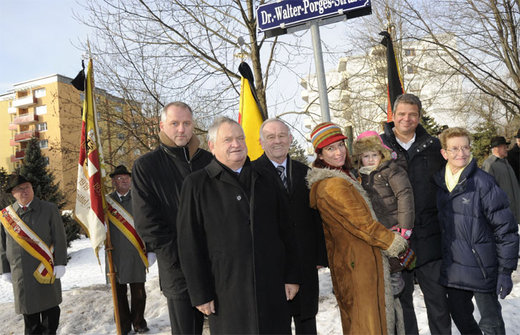
Stadtrat Robert Stadler, Herbert Haupt, Karl Anderwald, Brigitta
Waschnig mit smilia, Gerhard Köfer, Waltraud
Waschnig at
the inauguration ceremony of the Dr Walter Porges St.
"Die Benennung einer Straße nach dem jüdischen
Arzt Walter Porges ist ein Symbol dafür, dass eine demokratische,
offene Gesellschaft wachsam sein muss gegen Feinde der Demokratie."
Mit
diesen Worten umriss Karl Anderwald, Jurist und Publizist aus
Spittal, seine Bemühungen, die Verdienste von Walter Porges für die Nachwelt zu erhalten.
Anderwalds Initiative ist
es zu verdanken, dass seit Mittwoch die Straße zwischen
Friedhof und Neukauf im Osten Spittals "Dr.-Walter-Porges-Straße" heißt.
Nach einigen Anlaufschwierigkeiten wurde die Benennung dieser
Straße am 14. Dezember einstimmig im Gemeinderat beschlossen.
 Paul Porges (b. Spittal an der Drau 14/5/1932) Physician.
Paul Porges (b. Spittal an der Drau 14/5/1932) Physician.
married
Elisabeth Lettmaier (b. Vienna 1936). They live in Vienna.
 Walter Porges (b. Vienna 1965) married ... Lives in
Vienna.
Walter Porges (b. Vienna 1965) married ... Lives in
Vienna.
 Matthias Porges (b. 1989)
Matthias Porges (b. 1989)
 Philipp Porges (b. 1991)
Philipp Porges (b. 1991)
 Manettus Porges (b.
2012) Manettus Porges (b.
2012)
 Stefan Porges (b. Vienna 14/9/1966). Actor and
painter. Lives in Vienna.
Stefan Porges (b. Vienna 14/9/1966). Actor and
painter. Lives in Vienna.
 Dominik Porges (b. Vienna 1969). Lives in Vienna.
Dominik Porges (b. Vienna 1969). Lives in Vienna.
 Gisela Oliva Porges (b. Vienna
1971) Gisela Oliva Porges (b. Vienna
1971)
 Eva Elisabeth Porges (b. Vienna 1973). Physiotherapist.
Eva Elisabeth Porges (b. Vienna 1973). Physiotherapist.
 Marion
Porges ( b. Vienna 12/09/2007) Marion
Porges ( b. Vienna 12/09/2007)
 Anna
Lilian Porges (b. Vienna 1979) Anna
Lilian Porges (b. Vienna 1979)
 Jorge Paul Porges (b.
2012) Jorge Paul Porges (b.
2012)
 Franz Porges (b. Spittal an der Drau 1892, d. Bogotá,
Colombia 1985)
Franz Porges (b. Spittal an der Drau 1892, d. Bogotá,
Colombia 1985)
married
1920 Elfriede Lampe (b. Germany 1893, d. Bogotá, Colombia
1962).
Franz
escaped Nazis in 1938 and settled in Colombia. Elfriede followed,
but not their son.
 Rudolf "Rudi" Porges (b. 1923, d. Colombia
1983) married 1956 Hildegard Michaelis.
Rudolf "Rudi" Porges (b. 1923, d. Colombia
1983) married 1956 Hildegard Michaelis.
Rudi participated in WW2 with the German army and settled in
Colombia after the war.
 Renate Porges (b. 1959)
Renate Porges (b. 1959)
 Carlos Porges (b. 1962)
Carlos Porges (b. 1962)
|
Sources :
Ragnar Göran, January 2000
Dr Paul Porges from Vienna, currently Professor of anaesthesiology
at the University of Vienna.
Special thanks to Frida Göran, Waltraut Porges, Paul
& Elisabeth Porges and Johanna & Robert Marcus. |
|
| Dr.
Walter Porges, a general practitioner in Spittal, highly decorated
„Defense Fighter“, social democratic town councillor
lost his approbationafter the „Anschluss“. Patients
with little civil courage avoided his practice, others stopped
paying their invoices and became so passive complices of the
NS - regime.
Deported in 1943, Porges became a victim of the Holocaust
in Auschwitz.
|
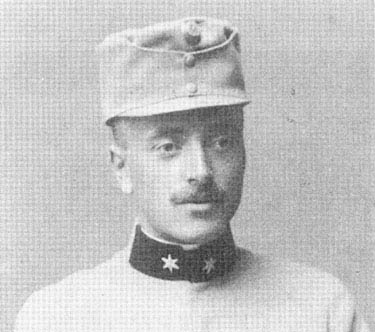 Quelle/Vir: Slg. A. E. Quelle/Vir: Slg. A. E.
|
Der Spittaler Arzt, hochdekorierte Abwehrkämpfer
und sozialdemokratische Gemeinderat Dr. Walter Porges verlor
nach dem "Anschluss" seine Approbation.
Aus mangelnder
Zivilcourage mieden Patienten seine Praxis, zahlten ihre Schulden
nicht mehr und machten sich auf diese Weise zu passiven Komplizen
des NS-Regimes.
Im Jahr 1941 verhaftet, wurde Porges in Auschwitz
ein Opfer des Holocaust. |
Antisemitism
After the “Anschluss”
the persecution of Jews was not only propagated with all possible
means but became also a constituting principle of NS policies.
Not without a shameful passivity and tolerance by indifferent
supporters the Austrian Jews were step by step excluded from
law.
Jews were not permitted to wear the local costumes like
“Dirndl”, “Lederhosen” and the carinthian
suit, Jews were not permitted in public baths and parks. The
269 Jewish community in Carinthia were successively excluded
from normal life : Civil servants were dismissed, lawyers and
physicians discharged from their professional chambers.
The
official introduction of Nuremberg race laws in Austria in May
1938 “legitimated” a great number of rules that
enabled the economic plundering of Jews.
The “Arisierung”
of Jewish property was accomplished with the “Vermögensverkehrsstelle”
in Klagenfurt with the aid of local banking institutes.
The
first culminating point of antisemitic agitation were the outrageous
assaults and plundering in the “Reichskristallnacht”
in November 1938.
The total extermination of Jews was promoted
not without an advancement of carinthian NS– protagonists
(first of them Odilo Globocnik) to servile executors of a perverted
vision of races.
An uncompleted list indicates that 48 carinthian
Jews were victims of this total extermination. |
Antisemitismus
Nach dem "Anschluss"
wurde die Judenverfolgung nicht nur propagandistisch auf jede
erdenkliche Art gefördert, sondern zugleich zu einem
bestimmenden Prinzip der NS-Politik erhoben.
Nicht ohne beschämende
Passivität und Duldung durch ein indifferentes Mitläufertum
wurde das österreichische Judentum Schritt für Schritt
unter Ausnahmerecht gestellt.
Die antisemitischen Maßnahmen
begannen mit symbolischen Diskriminierungen (Verbot, die Landestracht,
Dirndl, Lederhose, besonders aber den Kärntner Anzug
zu tragen). Juden war es untersagt, öffentliche Badeanstalten
zu besuchen und Parkanlagen zu benutzen.
Sukzessiv wurde die
269 Personen zählende jüdische Gemeinde in Kärnten
aus dem normalen Leben hinausgedrängt; als Beamte entlassen,
als Rechtsanwälte und Ärzte aus den Kammern geworfen.
Die formelle Einführung der Nürnberger Rassengesetze
in Österreich im Mai 1938 "legitimierte" eine
Vielzahl von Bestimmungen zur wirtschaftlichen Ausplünderung
der Juden.
Die "Arisierung" des jüdischen Besitzes
wickelte die Vermögensverkehrsstelle in Klagenfurt unter
Mithilfe lokaler Bankinstitute ab. Erster Höhepunkt antisemitischer
Hetze waren die Ausschreitungen und Plünderungen anlässlich
der "Reichskristallnacht" im November 1938.
Bei
der Massenvernichtung der Juden avancierten auch Kärntner
NS-Protagonisten (allen voran Odilo Globo?nik) zu servilen
Exekutoren einer pervertierten Rassenvision.
Einer unvollständigen
Liste zufolge fielen 48 Kärntner Juden dieser Massenvernichtung
zum Opfer. |
source :
http://gostje.kivi.si/total/part5/Verfolgung26.htm
http://gostje.kivi.si/total/ |
|
|
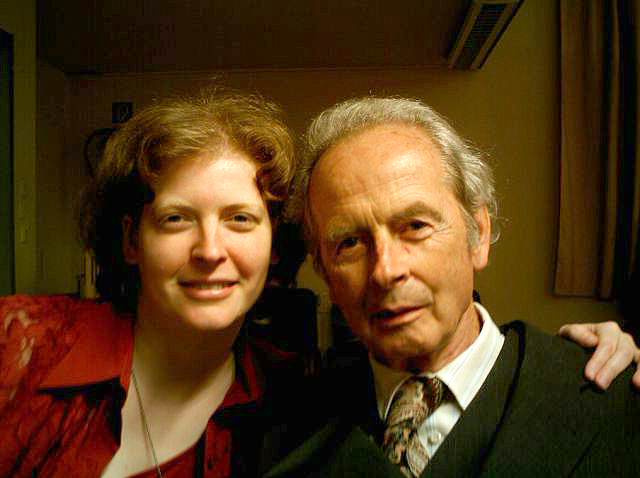
Gisela Porges and her father
Paul Porges (2006)
|
Brigitte - Paul - Waltraud Porges Autumn 1939 |
|
|
|
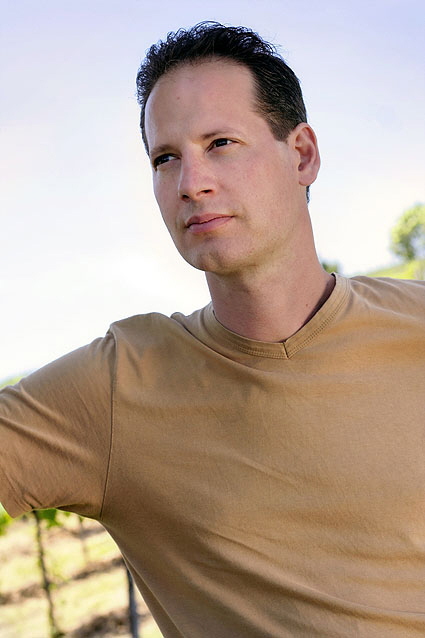
Stefan Porges (2008)
Click here to visit the
home page of Stefan Porges |
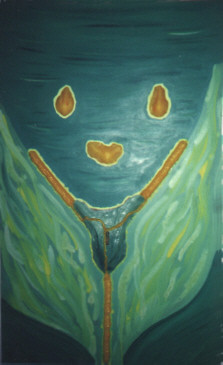
Painting by Stefan Porges
|
"Die Natur, von gegenständlicher-
figürlicher
Darstellung bis zu abstrakten Motiven, ist das Hauptthema
der Bilder des gebürtigen Wieners Stefan Porges.
Bei einem Großteil der Bilder wird um ein alltägliches
Element eine oder mehrere Ebenen von abstrakten Themen
komponiert.
Oftmahls wird gerade durch diese Elemente, die meistens
Fundstücke
sind, die reine Darstellung der Natur von einem sehr technischen
bzw. eher unnatürlichen Objekt gestört, oder
auch verschmolzen.
Die dabei verwendeten teils kräftigen Farben und die
durch das Material Silikon entstehende Struktur, verstärken
die Harmonie der Bildkomponenten und wirken im Auge des
Betrachters ganz individuell. " |
|
|
|
The little town Nyrsko (Neuern) is situated along both sides
of river Úhlava.
It was formerly divided in Oberneuern (Upper Neuern) and
Unterneuern (Lower Neuern).
Oberneuern was the part upstreams. |
In 1860 they counted 500 and 1000 inhabitants respectively.
Since 1868 the two parts are one unit.
Each house had a number, and numbers XVIII and 62 were the
houses where Samuel and Therese were born. |
I guess that the first occurrence of Porgeses in Neuern in
the mid 18th century was the result of the 1745 expulsion,
when all Jews had to leave Prague and find new dwellings in
the countryside.
Perhaps were all Porgeses one family before that ?
Ragnar Göran (2002) |
History
of the Jews of Neuern
The town of Neuern (czech Nýrsko)
is located on the headwaters of the River Angel, near the
Bavarian border.
...
The Jewish Houses of Neuern
as far as they were marked with Roman numbers (from 1771):
VII (137). Place where there was a fire, now a garden.
Before 1618 Abraham Zaparth, his son Wolf Zaparth (1655), Wolfs daughter Radisch
marries
1708 Salomon Abraham from Rabi.
1727 “through official channel for 50 Gulden the manorial little house
in the Judenwinkel of Neuern between Joachimb Hann and Jakob Melech
(Meller) was given to him”.
He paid annually 10 Gulden protection tax.
1742 the house was passed to his son Schmula Abraham Janowitz (1771 and 1784 called
the "junger Prager").
1800 Samuel Janowitzer, David Porges.
1815 Joachim Ploch, Moritz Bloch.
About 1880 Wenzl and Katharina Schwarz (Ruaße).
About 1890 it burns down, then demolished. Jewish community.
XVI (132), Dwelling.
1670 and 1692 Herschl Plach (grandson of Meyer Bloch "before 1618").
Wens Salomon.
1705 the house is bought by “Neidlwirt” (also called “neuer
Wirt”= new innkeeper) and David Simon for 150 Gulden.
1706 David Simon marries Schönle from Horaschdowitz. He was a son of Isak
and a grandson of the ancestor Jonas Windspach.
1746,1749 Sandl.
1759 Sandl or Daniel Simon.
1788 to Daniel Simon, also called Bergner, then to Salomon Porges (also
written Bories and Purias).
The house had a vault and a grocery.
One half of the vault belonged to Avigail Porges in the Frischmann's
house at the Jewish “Tandlmarkt” at Prague.
Salomon Porges around 1815 paid 15 Gulden protection tax.
Daniel Fleischl. Löbl Bloch. Daniel Bloch. Siegmund and Berta Bloch.
XVIII. Dwelling, which until 1861 stood at the current street,
across from the former (…) inn.
1732 Josef Österreicher and Hanna Wünschbachin.
1739 Chaim Österreicher, 1746 Maier Abraham Janowitzer, wool wholesalers,
feathers and cereals.
1794 to his brother Samuel Abraham Janowitzer.
1815 David Porges, 15 Gulden protection tax. Since then,
this house was extended into the street in a way a carriage could scarcely pass
; it was removed after the fire in 1861. Street.
The authorized families
of 1799
In 1799, a certain number of Jewish families for each dominion
was fixed by the government ; it was controlled and not
to be exceeded, because there was a constant increase of
Jewish families.
Within each dominium, the post for Jewish families were distributed
on the locations where Jews had already settled.
The families
of the Bistritz dominium started with the country’s
number begin 5143, so that each family had a country’s
and a dominium´s number.
In 1799, in the area of Bistritz,
there where 96 such "family posts" or "Familianten",
and they were mainly distributed between Neuern, Janowitz,
Drosau, Deschenitz and Braunbusch.
Neuern had the posts no.
11 – 29, then 64, 78, 80 and 81 : altogether 23 authorized
families.
Most Jews had Drosau with 24 posts, followed by Neuern with
23, Janowitz with 10, Deschnitz with 9, Braunbusch with 3
and Bistritz with 2 posts.
The remaining families were divided
upon smaller places.
Post 15 : Klauber Salomon (parents
and spouse unknown, married 1775) died (date unknown) without
children.
Successor on the post was Fleischl Daniel (from
post 11), his wife Susanna Porges (married 1819).
Sons: Albert, Josef.
Post 18 : Hahn Jakob (parents unknown). Wife
Magdalena N. (married 1774), died 1816 without sons.
Successo r:
Ploch Löbel (Parents: Gabriel Ploch and Johanna Schwarz).
Married
1829 Rosina Porges. Son Samuel.
Post 19 : Löwit Eliazim (parents and
wife unknown) no sons, "1805 verlustiget" (he
lost the post) (as poor taxpayer). Successor : Klauber
Elias (died 1832, parents: Nephtaly Klauber and Libuscha
Wiener) married 1806 Sarah Schwarz.
Son Hermann (born 1812)
received 1832 this post, married 1834 Rebekka Porges,
son Josef Eduard (born 1838, died 1839).
Post 25 : Porges Salomon (Parents:
Jakob Porges and Rachel N.), married 1788 Abigail Berger.
Son David got his father's family post, married 1814 Barbara
Janowitzer, son Solomon in 1843 moved to Hungary, son Samuel
married 1839 Fanni Epstein, née Reichenbaum, son Lippmann.
In Millik:
Post 53: Fleischmann Moises.
It is striking that in 1799 no post existed in Holletitz.
There was a brandy
distillery of the dominion/rule of Bistritz which stood beside the brick shack,
right of the Neuern road to the railway station (…), which usually was
operated by a Jew.
1799 in Janowitz there is a post occupied by the Jew David Holletitz.
This name
indicates, like many other names already mentioned (Janowitz, Neumarkt, Neuern, Österreicher (=
Austrian) the former residence and subsequent origin of these families.
The regulation of the numbers of Jewish families forced the larger part of the
offspring of each community to severe resolutions.
The progress of the era provided
resorts which reduced the plight of the later-born.
Already the patent from Nov
1st 1781, with which bondage was repealed, freed all subjects – and hence
as well the Jews – to choose a craft or skill without permission of authority.
This opened new possibilities to all the second sons who hitherto were doomed
to singleness or emigration.
Farming, trade, art and qualifications as a surgeon
became frequent new paths to establish one's own family.
Also in the Bistitzer
dominium this boon was applied and hence in the year 1809 Isak Ploch in Neuern
(post Nr.14) received the marriage license as a farmer, 1844 Joel Klauber (born
1804) from Lower Neuern got the marriage license as a butcher and 1849 Isak,
son of Moises Küberl from Drosau got the marriage license as a weaver.
Emigration
anyhow didn’t stop.
In 1812 Lazar Hartmann Drosau emigrated to Hungary,
and that without consent of authority.
In 1843 Salomon Porges and Aron
Janowsky from Neuern went to Hungary and one year earlier Löwit
Simon from Drosau (…) emigrated to America, perhaps the first resident
from our area who dared to cross the great ocean.
The trading of feathers in Neuern
The small, insignificant town of Neuern
soon outdid the royal towns of western Bohemia (Pilsen,
Taus, Klattau) in feather trading.
How was it possible?
We have seen that the Jews of the area were the real creators and promoters of
this trade.
However, the royal towns had an old privilege according to which
they didn’t have to tolerate Jews within their walls.
They did use this
privilege. Hardly did they accept the economic assiduous Jews to stay overnight
within their walls at the time of market.
Because they could not gain ground
here they transferred their action on the grounds of nobility in the periphery
and hinterland of these towns.
In Neuern they had the near border and important
trade routes, easy access options, the promotion of the Lords (…) and
the existence of a densely populated area which was needed to work up the feathers
and the trade as pedlars.
Since trade with geese and feathers from its beginnings was aimed to the “Reich”,
which means towards west, it is easily understandable that these goods were accumulated
in the western Bohemia.
Here (…) since ever were collected the geese and
bales of feathers, the abundances of the country, in order to take its way to
Germany.
(…) The region of Taus, Neumark and Neuern till Dosau was the
main square of the bohemian, later the European trade for bed feathers. Neuern
was the centre of this trade.
In an earlier edition of Mayer’s Encyclopaedia
Neuern is named downright the centre of the European trade in feathers.
For the
old age and the importance of this trade for West Bohemia speaks the fact that
already in the 14th century, under Emperor Charles IV, the town of Taus received
the privilege beside of holding a market of two weeks, to export feathers.
(… …)
In Neuern the Jewish Community had to pay 15 Gulden for a special “feather
trade tax”.
In the middle of the 18th century here Meier Abraham Janowitz
(bought house no. XVIII from Khanny Österreicher) ran the largest feather
business.
(…) (Together with his brother Samuel Abraham Janowitzer – house
no. VII –) he founded a trading company in which they affiliated in 1783
also Meiers wife Sorl and his underage son Aron.
For the latter they ensured
a heritage of 500 Gulden.
The company ran under the name "Meier und
Samuel Janowitzer " and after Meier’s death under "Samuel
und Meier Janowitzer seel. Erben''.
It didn’t last long under this
name ; already in 1790 Samuel Abraham Janowitzer closed a "firm contract
in wool and feather trade" with his two sons Wolf and Abraham for six years.
(…) The company was named Samuel Janowitzer and sons.
(…) When Samuel Abraham Janowitz was nominated in 1769 for the post as Judenrichter (Jew’s
judge) he asked the authority to not consider him because he
had “considerable Kapitalien and his work constrain to travel
often and far (…)”.
Count Palm was appreciative of his arguments
and assigned the office of Bistritz to nominate someone else as judge.
This trade company which worked with – for this time – extraordinary
means and span business connections over a major part of Bohemia changed its
name then in “Janowitzer, Porges & Co”, later
in “Janowitzer & Fleischl”. (…)
The present owner, Mr.
Alexander Fleischl, is also Royal Danish consul.
Also very old is the company Klauber, today “A. Klaubers Sohn” in
Neuern.
It conducts a steam cleaning and ships feathers to mail order companies
and small national and international stores.
Around 1840 one of the largest feathers stores in Neuern was the Company Porges,
Vater & Sohn ; for the period around 1800 must be remembered the
business in bed feathers in Neuern Hönig Hahn (…).
(…) The
Neuern feather business took a lively boom after the French Wars and especially
after the big fire of Hamburg (1842).
Around 1845 from the Neuern area an annual
quantity of 10.000 cwt was exported to Germany, Switzerland, Holland and France.
Around 1800 a town in Western Bohemia tried to dispute Neuern its dominating
rank in the feather business : Alt- and Neuzedlisch near Tachau, with an old and
rich Jewish community.
The founder of the house Rothschild in Paris is said to
have made efforts to get in contact with a wholesale dealer of Altzedlisch, but
without success.
Large fires prevented the further expansion of these towns and
Neuern left these competitors far behind.
The Neuerner Jewish feather merchants,
restricted by many illiberal regulations and prevented from travelling and peddling,
were forced to look for a way out which they found in engaging the Christian
population of the Angel Valley and send them worldwide to sell their products.
The business grew and developed well.
(…) Soon a network of branches spread
over the whole German Empire and the alpine Länder.
As the Christian
salesmen travelled in company (…) for cases of emergency they had to be
able to communicate even in the presence of their customers in a way that was
incomprehensible for them.
Therefore their patrons, the Jewish business magnates
(…) had equipped them with a kind of secret language which vocabulary
almost entirely derived from Hebrew.
Some snatches/chunkes of this feather trading
jargon is still alive in the Neuern idiom.
The sheep wool trade stood in close relationship to the feather trade (…)
while feather were the filling of cushions and blankets. (…)
There were sheep flocks in each village and markes at these times.
The wool was
cleaned and combed in homes, partly spun and worked to stockings and Scherkenstoff
(??).
The wool that was not consumed in homes was given to the traders, for export.
Special licenses were requested for this purpose.
In 1768, the Bistritz authority
certified that Mayer Abraham Janowitz from Neuern had charged a cart with 14
bags of domestic Bohemian wool.
He wanted to carry it “through the electorate
Bavaria to Salzburg and Tirol.”
Around 1790, the company Samuel Janowitzer & Söhne
was the conventionary purchaser of the herrschaftliche wool. |
|